| ________________
CM . . . . Volume XXI Number 8 . . . . October 24, 2014
excerpt:
Don't let your first glance at these books deceive you. Unlike many nonfiction books for primary students, these books do not use infographics, text boxes, charts, and other eye-catching techniques to present information. Take a closer look, and you will see that these are nonfiction picture books. Approximately 80% of each double-page spread is a beautiful image of plants and animals in the habitat of the book title. The other 20% is simple text describing the climate and surroundings being portrayed. The text also incorporates the names of many of the plants and animals in the pictures, encouraging the young reader or listener to look deeper into the image to discover what is hidden there.
The books include a world map to identify the locations of the different ecosystems around the world and to identify the specific area of the prairie, reef or dessert ecosystem that is described in the books. Also included at the back of each book is additional information about some of the ecosystem's inhabitants. These highlights consist of a brief description accompanied by an illustration of the plant or animal. This additional information section is followed by a glossary. Unfortunately, words in the glossary are not highlighted in bold in the text, nor are they linked to a page number.
As in the earlier books published in this series, these books do not include a simple table of contents or index. For example, in Who Needs a Desert?, an illustration and description of a roadrunner is included at the back of the book, but, if you want to find the information about roadrunners in the body of the book, you have to search page by page. In my opinion, this continues to be a weakness that could be easily remedied. The addition of a table of contents and index would make the books more usable as a nonfiction resource, enhancing their value to young researchers, as well as pleasure readers.
One of the strengths of the series is that the books are organized to include similar content. For example, each book opens with an overview of the ecosystem titled "Welcome to the Desert", (or "Prairie" or "Reef"). They also include descriptions of what it is like to live in each ecosystem, a food chain, examples of life cycles, and an explanation of the importance of each ecosystem. Each book ends with the question, "Who needs a desert (or prairie, or reef)?" and the answer, "We all do." A bonus is that the back of each of the dust jackets for these hardcover books is a poster. If you are willing to part with the dust jacket on the book, you will have lovely posters for your classroom or library. Who Needs a Desert? looks at how desert plants and animals survive in extremely dry conditions. This book treats hot deserts only and examines how weathering and dramatic variations between daytime and nighttime temperatures help create sandy soil and sand dunes. Both plants and animals make the most of the summer rains to grow and reproduce in the short opportunity provided by the availability of water.
Who Needs a Reef? examines not only the life in and around a reef but also how a reef protects the shoreline and how beaches and harbors develop. Even a reef at nighttime is brought to life in Patkau's illustrations. Coral reefs around the world are shown on the map. The reef described in this book is in the Caribbean Sea. Once again the books in this series contain valuable information supported with beautiful illustrations that help young readers understand the content. The message in each is clear. We need to care about these different ecosystems. Each is different, and each is important, not just to the plants and animals of that ecosystem, but to all of us. Highly Recommended. Suzanne Pierson is a retired teacher-librarian, currently instructing Librarianship courses at Queen's University in Kingston, ON. Copyright © the Manitoba Library Association. Reproduction for personal use is permitted only if this copyright notice is maintained. Any other reproduction is prohibited without permission.
Next Review |
Table of Contents for This Issue
- October 24, 2014. |
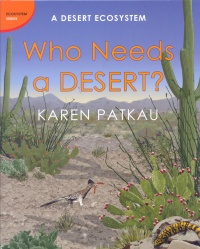
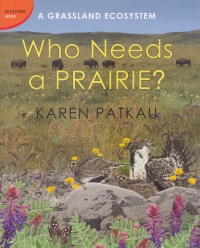
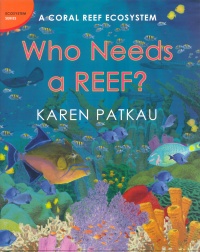
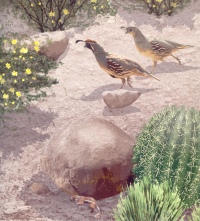 Author and illustrator, Karen Patkau presents information in an easy to understand format for young readers. Each book includes simplified text for young nonfiction readers supported by detailed illustrations of the plant and animal life in each ecosystem. These books can also be read to younger readers.
Author and illustrator, Karen Patkau presents information in an easy to understand format for young readers. Each book includes simplified text for young nonfiction readers supported by detailed illustrations of the plant and animal life in each ecosystem. These books can also be read to younger readers.
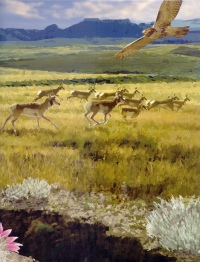
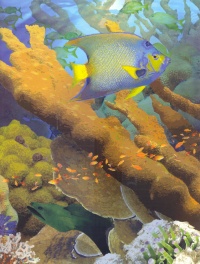 Who Needs a Prairie? is filled with beautiful pictures showing the variety of life on the prairies. The text leads the readers to look more closely at the accompanying pictures to find the plants and animals that are almost hidden in the grassland. If you aren't sure what a "yellow-bellied racer" or a "pipit" look like, you can look them up in the additional information at the back of the book and then look again at the illustration to see if you can find them.
Who Needs a Prairie? is filled with beautiful pictures showing the variety of life on the prairies. The text leads the readers to look more closely at the accompanying pictures to find the plants and animals that are almost hidden in the grassland. If you aren't sure what a "yellow-bellied racer" or a "pipit" look like, you can look them up in the additional information at the back of the book and then look again at the illustration to see if you can find them.